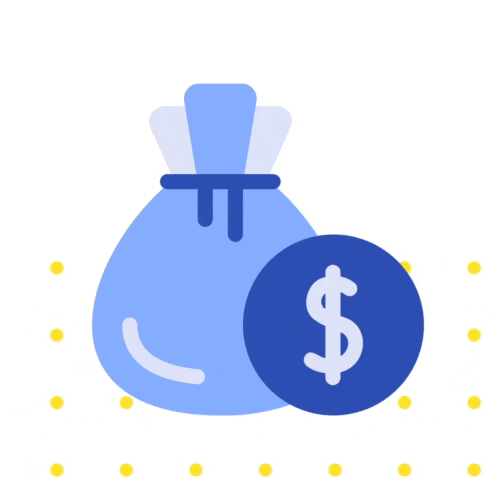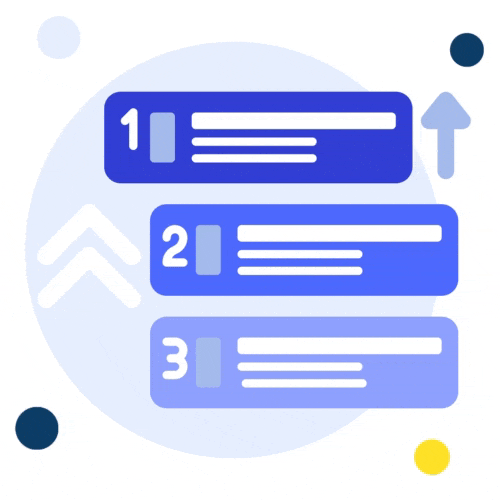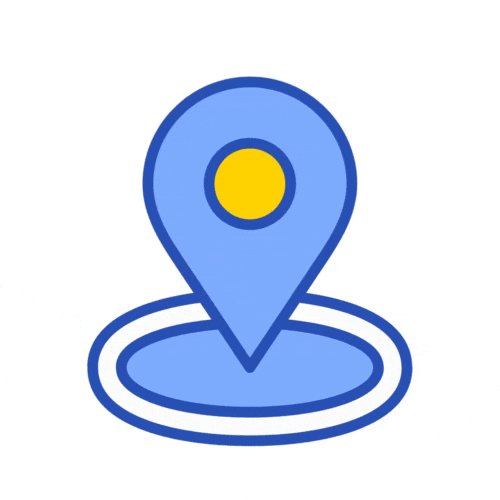Scaling Success: How We Took One Client from Zero to a Million-Dollar Empire in One Year!!

Is it possible to turn a business that's still under construction into a one-million-dollar company within a year?
Our client tasked us with achieving precisely that, and we delivered. In this case study, we'll guide you through our step-by-step process.
We'll show you the exact marketing playbook we used to tackle each challenge (there were many) and ultimately deliver on our client's goals.
Table of Contents
This comprehensive case study will give you insights into the following:
Before jumping into these strategy points, let's look at the challenge we faced.
The Challenge: Achieving $1 Million within a Year…from Scratch
Our client was launching a new practice in a highly competitive market with numerous well-established businesses offering comparable services. To expand, we had to capture the market share from these established players.
They wanted to grow aggressively, take a brand new business with no revenue and no online presence, and grow it to a $1 million company in one year. We had to build everything online from scratch.
Needless to say, this was a challenging undertaking.
So, how did we achieve this seemingly insurmountable feat?
The Steps
Our team took a systematic approach to create a detailed strategy. These are our exact steps:

#1 Establish Goals

Every project has to have a plan. But, even before you put a plan in place, you have to establish goals.
Setting clear goals helps you better understand what you're trying to achieve and provides focus. Goals can differ from business to business. So, understanding precisely what our client wanted to achieve helped us determine which critical actions to take first.
Some questions you should ask when choosing your business goals:
What are your short-term and long-term aspirations for your business?
What are the most significant challenges you face in achieving those goals?
How will you measure success? What metrics will you use to track progress?
Once we understood our client’s goal was to grow to $1 Million in revenue within one year, we could then reverse-engineer and establish a practical plan for the precise number of clients we had to attract for their unique business.
#2 Market Research
Market research helps plan for potential challenges, reduces risk, and creates possibilities. It forms the foundation of a business strategy geared toward future revenue.

For this project, our market research involved three main areas:
Industry Averages
We researched industry averages for marketing and sales data, exploring similar industry players, media strategies, and buying patterns.
We analyzed cost per lead ($75-$125), customer acquisition cost ($225), customer churn, and expected average annual revenue from customers revealing significant insights to inform our overall strategy.
Environmental Factors
The success of a marketing campaign is dependent on several environmental factors.
As part of our market research approach, we conducted an in-depth analysis of current competitors, revealing that there were already three competitors who had a commanding online presence in their territory but were not actively enhancing their online brand.
We also looked at the impact of seasonality, demographic factors, and other factors. Data pulled from Google Ads research helped to determine estimated media costs with a range where we could expect to be competitive based on our prior campaigns
Current Online Presence
Evaluating a business's current online presence and identifying its strengths and weaknesses is essential to determine how to improve it.
Since the client had no website or social media platforms, we had the opportunity to start afresh, but it also meant facing the challenge of building an online following from scratch.
#3 Budgeting
We work smart for our clients and use data to make marketing decisions. Intuition has its place, but when it comes to investing money, data is crucial. Understanding and interpreting data is essential for making impactful decisions on budgeting.
We collected and analyzed data during the market research phase to create a realistic marketing budget. This ensured we hit our targets based on data, not intuition.

Based on market research data, we built a budgeting tool and then had the client help set the variable factors that would ultimately determine an annual budget.
#4 High-Level Marketing Plan
Creating a focused and concise marketing plan is vital for any business. After setting a budget range, we initiated a process called Decision Journey Asset Mapping:
-
We mapped out how consumers make decisions using the consumer decision journey. Then, we compared it with the marketing assets that the client has or needs to have to influence their purchase decisions.
-
We identified sales and marketing touchpoints and focused on the buyer's journey as they evaluate the business's product or service offering.
-
After mapping out the touchpoints, we implemented effective strategies and tactics at each point. We also identified the necessary marketing assets for each touchpoint.

With the company goals defined, market research completed, an initial budget range outlined, and a marketing plan, we had the foundation of this new business! We were then ready to tackle the website.
#5 Website Development

Developing a successful website is not as straightforward as it may sound. There is more to it than getting a logo and information about the business and its offering and presenting it online on a few well-designed pages.
Website development is a systematic process - we approach the process in seven key steps:
Services
We first looked to define each service the business has. It makes planning the website so much easier when you can see everything you need to include from an overview.
We worked with key personnel to lay out every aspect of the client's service offering and business information, including their mission and vision statements.
We worked to define an inventory of the client's services and how those services would be displayed in the navigation. Each service needed to have a separate page to ensure they would rank well on Google.
Target Market
The target audience determines your website's look, feel, and content.
With consideration given to the demographics, psychographics, and sample customer personas, we defined an ideal customer for this brand. Since this client's target market was local, we defined the target cities/regions they would likely attract clients from and then built content around those targets.
Based on this information, we decided to create a minimalistic, sleek design that would appeal to this client's broad demographic and match the brand identity. Our focus was on navigation, mobile responsiveness, and lead generation.
Keyword Research
Keyword research is the very foundation of your website's content. When used correctly, it helps customers find you online and help them locate the content they're searching for quickly. Keywords should match the brand's voice and what the business offers.
We worked with our client's team to analyze their service offering. Based on this information, we did detailed keyword research using some of the top keyword research tools in the industry. We were able to determine the relative demand for each keyword as well as what supporting terms to use.
Information Architecture
Information architecture determines the organization and structure of information on a website. It involves organizing content and information in a logical and user-friendly way, making it easy for users to find what they are looking for and navigate the site efficiently.
We created an effective information architecture that helps users to understand the website's content and purpose quickly and provides a seamless user experience. We recorded this enabling our team to maintain, update, and expand as the business needs.

Photography
We take into account that most consumers tend to visit a company's website before its physical location.
We enabled the company to showcase its experiences and create an emotional connection with its potential customers. One major way to do so was selecting the right photography to use on the website to attract and engage the target audience.
Although stock photography can be suitable for many applications, we desired a more personal and genuine touch for our online presence. Therefore, we enlisted the assistance of a nearby photographer to capture photographs of both the interior and exterior of our facility, as well as lifestyle and profile shots of our staff. In addition, we were able to utilize b-roll video footage to highlight specific elements of our facility and enhance the overall user experience of our website.
Content Development
Developing high-quality content for a website is necessary for achieving good SEO rankings, engaging visitors, and promoting customer engagement. While the overall design and photography are essential for making a good first impression, it is the content that keeps the target audience engaged.
In this phase of the website design process, we focused on developing a content strategy based on keyword research, business goals, target audience, competitor analysis, personal interviews, and brainstorming sessions with the client's stakeholders. The goal was to create compelling and informative content that resonates with the target audience and encourages them to take the desired action.
Lead Capture
Depending on where your website visitors are in the decision journey, some visitors will take action the first time they visit your website. Others will come back a few times before making a decision. Many need a little nudge.
We worked with the client to create a lead capture form in a strategic area on the website. It contains business-specific questions and a clear and strong call-to-action (CTA) to encourage the user to take the next step and reach out to the client.
#6 Search Engine Optimization (SEO)
Most people use search engines to find products or services. Therefore, you need to use search engine optimization (SEO) to ensure your website can be found on page one of Google.
There are different types of SEO strategies, and they're all important. For this client's website, we tackled four main SEO areas:

Local SEO
Local SEO makes it possible for your business to be found in local search results.
For this client, we did the following:
-
Optimized the website for local keywords: Used relevant local keywords throughout the website, including page titles, meta descriptions, headers, and content.
-
Claimed and optimized their Google My Business listing: Claiming and optimizing your Google My Business listing is one of the most important steps in local SEO. It helps your business show up in Google Maps and local search results.
-
Built local citations: A citation is any online mention of your business's name, address, and phone number (NAP). Building local citations helped improve the client’s visibility in local search results. We built over 70 local citations for this client.
-
Got listed in local directories: Getting our client’s business listed in local directories such as Yelp, TripAdvisor, and Angie's List also helped improve your visibility in local search results. For this client, we also included listings that were local and specific to their industry.
-
Encouraged online reviews: As an ongoing step, we gave our clients the tools and knowledge to encourage their customers to leave positive reviews on sites like Google, Yelp, and Facebook. Positive reviews can help improve your visibility in local search results.
On-Page SEO
On-page SEO involves creating effective and informative content that potential customers and search engines look for. For this client, we used the following strategies:
-
Optimized Page Titles and Headings: Included target keywords in page titles and headings to make it easier for search engines to understand what the page is about.
-
Used Descriptive URLs: Used clear, concise, and descriptive URLs that included target keywords.
-
Created High-Quality Content: High-quality content that provides value to the client's site users. We used target keywords naturally in the content.
-
Used Image Alt Tags: Used descriptive alt tags for images that included target keywords. This helps search engines understand the content of the image and improves accessibility for users.
-
Optimized Meta Descriptions: Meta descriptions are short summaries of web pages that appear in search results. We created these for each page and included target keywords and a call to action to improve click-through rates.
-
Internal Linking: Linked to relevant pages within the client’s website to help search engines understand the hierarchy and structure of their content. This also helps users navigate the website.
-
Used Responsive Design: Used a responsive design that is optimized for all devices, including desktops, tablets, and smartphones. This helps improve user experience and search engine rankings.
Blogging
Blogging is an invaluable SEO tool. Every article on your website should be created with SEO in mind and optimized accordingly. For this client, we continue to create content as part of our ongoing strategy using the following:
-
Focus on long-tail keywords: We incorporate long-tail keywords into these blog posts. These are phrases that are more specific and targeted and can help us rank higher in search results.
-
High-quality content: We have an experienced team of SEO-certified writers that ensure blog posts are well-written, informative, and engaging to your target audience. The longer visitors stay on your website reading your blog, the better it is for your SEO.
-
Internal linking: We link to other relevant pages on the website within blog posts. This helps search engines understand the structure of the website and can improve rankings.
-
Optimize images: We use descriptive alt tags and file names for blog post images to help search engines understand what the image is about.
-
Promoting blog posts: We have ongoing strategy meetings with this client to help inform how to share this content to relevant channels to drive traffic to their website. The more visitors you have, the higher your search engine rankings will be.
-
Updating blogs regularly: We update the blogs with fresh, new content signals to search engines that your website is active and relevant, improving your SEO over time.
Link Building
We incorporated the following link-building strategies:
-
Natural Backlink Profile: We focused on building a natural backlink profile with many low domains which looks like this (Image). We built 93 backlinks in total.
-
Link reclamation: With this being a new business, there were a ton of instances where the brand was mentioned but not linked to in the first months of business. We helped to reach out to the author or website to request links.
-
Infographics: We created informative and visually appealing infographics and shared them on relevant websites and social media platforms to attract backlinks.
-
Collaborations and partnerships: We made local connections for the brand using our cold outreach templates to establish more backlinks.
-
Directory listings: We submitted the client’s website to relevant industry directories to acquire links from authoritative sources.
#7 Online Citations
Online citations are online business directories. Citations typically feature the business's name, address, and phone number. It helps internet users find local businesses and influences local search engine rankings, particularly on Google Maps.
Citations are influential because they help build the credibility of your business and help potential customers find accurate information about your business.

#8 Google My Business
Setting up a Google My Business (GMB) account is an essential part of any local business's marketing plan for several reasons:
Improved Visibility: With a GMB listing, your business will appear on Google Maps and in local search results, increasing your visibility to potential customers in your area. This is especially important for small and local businesses that rely on foot traffic and local customers.Improved
Increased Credibility: A verified GMB listing adds credibility to your business, as it shows that you are a legitimate and trustworthy operation. It also allows you to showcase your customer reviews and ratings, which can influence a potential customer's decision to choose your business over others.
Better Customer Engagement: A GMB listing allows customers to easily find and contact your business, including phone number, website, hours of operation, and directions. You can also post updates, photos, and other information about your business, making it easier to engage with your customers and keep them informed.
Cost-Effective Advertising: Setting up a GMB listing is free, making it a cost-effective way to advertise your business. You can also run paid Google Ads campaigns directly from your GMB account, allowing you to reach a larger audience and increase your visibility even further.
For our client, our team performed in-depth keyword research to include in the profile, wrote a compelling business description, and completed all critical sections of the profile.
How to maintain and grow
It's easy to maintain information about products and services, including pricing, details, and updated photos, on Google My Business. It's also an excellent platform for customer engagement, as the messaging system allows you to speak directly to customers.
Google My Business is one of the top consumer and business review platforms. You can take advantage of this by asking customers to give you reviews and responding to the input. Reviews will help shape your business' reputation online.

We set up an easy-to-use automation system to help our clients immediately send review requests to their customers as soon as they leave their location. Our system also helps clients respond to positive reviews, boosting SEO and their online reputation.
A Google Business Profile is invaluable in marketing a company with a local presence. Aside from guiding our client on setting up their GMB profile, we have strategically maintained its activity and presence to stand out from the competition as part of our ongoing contribution, along with setting up several automations to make maintenance easier as they continue to scale.
#9 Social Media
Social media platforms are not only a go-to when potential customers search for products and services. It's also the ideal place for businesses to engage with customers, build brand identity, and reach new audiences with engaging content. With social media, you can:
Learn more about the target audience and its needs
Expand your customer base
Build relationships
Work with influencers
Sell products or services
Run advertising campaigns
Host contests
Learn to improve strategies based on analytics

Market research is also critical for selecting the right social media platforms to have an online presence. Your target audience can have a significant impact on your social media strategy, influencing platform selection, content creation, messaging, timing and frequency, and engagement strategies. It is important to conduct market research and continually monitor your audience's behavior and preferences to ensure your social media strategy remains effective.
For this client, we determined that Facebook was the most effective way to reach their audience based on our demographic and psychographic research. We created a Business Facebook Page for the client, and a content strategy focused on a variety of strategies, including educational content, testimonials, promotions and discounts, FAQs, behind-the-scenes content, interactive posts, and more!
#10 Media Planning
Media planning is structuring how, when, and where you will deliver branding or marketing and advertising messages to receive the maximum ROI. You could choose to use print or digital formats or a combination of both to get in front of key customers. It's all about getting your message in the right places in front of the right people! And there are a few ways we use to help you figure out which methods are best.

Decision Journey
The decision journey is how customers make purchasing decisions. Having a deep knowledge of this helps form a solid foundation for your marketing plan. It allows businesses to focus marketing strategies on the most influential touchpoints and adapt strategy as the decision journey evolves.
For this client, we identified the different steps in the decision journey for their ideal customer personas. We understood from our market research that the client's prospects would perform most of their research online, so we focussed our efforts on online media placement.
Target Geography
Media campaigns should overlap your service area and/or where your customers are coming from. Correctly mapping your media to your target geography will significantly reduce your media waste and improve your budget impact.
For example, I worked with one of my clients to map their customer files geographically. We identified that 80% of their sales came from a 20-mile radius through this process. However, they used media options that extended their message to over 2 hours away.
You might be thinking, the more, the merrier, right? However, in reality, what this means is that they were paying to reach an audience that would theoretically never become customers. This means that they were wasting all of those advertising dollars.
In this case study, our client was a local business that only provides in-person services. So when it comes to target geography, this was well-defined.
Target Demographics
Demographics include essential characteristics of potential customers such as age, income, occupation, interests, and family structure, just to name a few. Buyer demographics tell you what type of content and messaging will resonate the most with your target audience.
We use several tools to collect demographic information for our client’s target audiences. We also provide audience segmentation, breaking down demographics so clients can accurately target potential customers. Another advantage of digital media that we used for this client was targeting certain age ranges and family attributes to fine-tune our targeting efforts.
Intent
Intent-based targeting is a powerful strategy that can improve your marketing efforts. This method targets potential customers based on their online behavior and who is most likely to make a purchase. This method requires a data source so you can identify prospects actively searching for your product or service.
While not always available, based upon the client industry, we used buying intent to capture prospects that were already in the market for our client's service offering
Media Vehicles
For this client, we directed our attention towards media vehicles such as Facebook, Google Search, Google Display, and Yelp, which are platforms utilized to transmit your message to your intended audience.
This allowed us to create a layered strategy that grew client awareness while also targeting users who were already closer to the point of purchase.

#11 Creative Development
For your business to stand out, you have to create a unique digital experience for the user consisting of appropriate messaging and high-quality imagery.
Messaging
Creative messaging is critical for effective brand positioning. Your business' message shapes the audience's perception of your products and services. A creative message strategy combines various elements to deliver your unique selling proposition (USP) in the right tone. Our ad copy for this client was clear and direct and included a compelling offer as well as a strong call to action
When writing our client’s website copy, along with SEO optimization, we focused on the benefits of their services as well as the ideal outcomes and the actual impact or solution each service offered beyond the tangible benefits.
Graphic Design
Graphic design is an integral part of developing a consistent brand identity no matter where you are online. It uses graphical images, photos, typography, and graphs to communicate your ideas, products, and services to the target audience.
We standardized the client's brand identity to present the business as uniform, consistent and professional. We helped design a brand-new logo and selected the right font and colors that reflected a soft, warm, and welcoming presence.

#12 Tracking & Analytics
Tracking data and analyzing what it means gives our client business owners access to valuable information, such as how the customers navigate the website, which pages they linger on, and where they bounce. It helps us identify poorly performing pages, lower bounce rates, and increase website conversion rates.
We use the latest tracking and analytics tools available to measure the impact of our efforts on our client's business. After tracking for a few months, we reviewed the following data to make necessary tweaks to the client's website to optimize it.
Call Tracking
Call tracking will give your business exact performance data identifying which ad campaigns are driving phone calls and delivering the best ROI.
The call tracking we used indicated which campaigns were the most successful. The client could use this information to develop future campaigns with a higher success rate.

Google Analytics
With Google Analytics, you have valuable data about your audience at your fingertips. It helps you determine where most of your traffic comes from and gives you all kinds of information about visitors to your site.
Google Analytics played an integral role in keeping tabs on all of this valuable information over the year.
Digital Ads Tracking Links
A tracking link is a snippet of text we implement at the end of a URL to track where traffic comes from. In digital marketing, it's one of the ways to pinpoint specific sources of traffic to your website. It enables us to track which digital ads are effective and which ones are not.
We used these for our campaigns for this client to track, optimize and pivot as needed, which enabled us to dramatically increase the success rate of our campaigns over the course of the year.
During the early stages of the campaign, the client expressed a desire to reduce their advertising efforts. However, due to the tracking measures that we had put in place, we were able to demonstrate to the client the direct impact that pulling back on their campaigns had on their lead generation. This provided the client with real-time data to inform their decision-making and ultimately led to a resumption of their advertising efforts, allowing for continued lead development.
Online Marketing Dashboard
We created an online marketing dashboard for this client so they can access, visualize, and pull templated or customized reports on data across all of their efforts.
It conveniently pulls all data points into one place, such as Google Analytics, Facebook, Instagram, Google My Business, and so much more. Our client doesn't have to log into multiple profiles to access essential data and use it to their advantage allowing full transparency and accessibility to all of their marketing data, whether or not it is from our services.
Post-Launch
There is so much excitement in getting your website and campaigns up and running that you may sigh relief once everything is finally launched! However, that's not where the work ends. In reality, launching your campaign is just the beginning!
As you've seen, analytics play an ongoing role in tweaking campaigns and web pages to improve sales. However, the data is even more in-depth than the tracking and analytics we've already discussed.

Campaign Reporting
We continue to analyze results and test parameters to measure the ROI of marketing efforts. A campaign report compiles the analytical data relevant to the effects of online campaigns or activities.
Our goal is to accurately put the most pertinent data together to measure effectiveness vs. objectives in a standardized report. This helps our clients reevaluate objectives and shift goals as the business evolves.
We continue to meet with our clients often to discuss campaign reporting, ROI, and future goals so we can continuously recalibrate marketing efforts.
Monitor & Optimization
Three key items that we continually monitor and recommend for any business include:
Campaigns
We monitor every campaign to measure ROI and effectiveness and provide recommendations on how they should alter future campaigns for improved success.
Website
We optimize our client’s website to bring more traffic and help convert visitors into customers. Using the analytics packages we outlined earlier, we perform attribution analysis on their website traffic to identify ways to enhance the user experience.
Citation
We keep an eye on all citations to ensure accurate information. It is the front line for everyone visiting our client’s website and must be maintained.
Summary
To achieve a revenue target of 1 million dollars in just one year for our startup client, we introduced a step-by-step approach that included establishing clear goals, conducting thorough market research, reverse engineering a budget to meet their goals efficiently, developing a high-level marketing plan, optimizing the website for search engines, leveraging online citations and Google My Business, selecting and executing a social media strategy, building a media plan, creating an effective messaging and design, implementing tracking and analytics tools, and performing post-launch maintenance.
Results

Our team of seasoned specialists collaborated with the client to undertake all the essential groundwork outlined above. As a result, we had everything set up to launch the plan in the first quarter of the year.
At the one-year mark, we had served more than 2.3 million impressions, driven nearly 20k site visits, and generated more than 2.7K leads. This enabled the clients to convert more than 875 clients and achieve their revenue goal of establishing a $1M business within their first year of operation.
Conclusion
Technology shifts in leaps and bounds, and marketing strategies can transform overnight. Best practices for website development and Google search algorithms also change. The digital landscape is dynamic, and those navigating it have to have a process in place to keep up with changes.
With thorough planning, continuous monitoring, and optimization, a business's online presence can drastically increase profits. Working with a team of professionals with years of industry experience will help you launch your online presence the right way and optimize it for maximum returns.
Want to Optimize Your Business for Success?
If this case study has piqued your interest and you would like to explore how our team can assist your business, we welcome you to get in touch with us.
Simply click on the blue button below to schedule a discovery call with one of our marketing strategists. We look forward to turning your business into a success story like this one!
